Indigenous Canadian personalities facts for kids
Indigenous Canadians are the first peoples who lived in the land now known as Canada. They have played a huge role in shaping Canada's history for hundreds of years. Their customs and culture have strongly influenced Canadian art, music, laws, government, sports, and even war.
The Indspire Awards are special awards given out every year by Indspire. These awards started in 1993. This was when the United Nations called the 1990s the "International Decade of the World's Indigenous peoples". The awards celebrate the amazing achievements of Indigenous people in Canada.
June 21 is National Indigenous Peoples Day in Canada. This day celebrates the important cultural contributions of Canada's Indigenous population. It was first celebrated in 1996. This happened after Governor General of Canada Roméo LeBlanc officially announced it.
In 2006, over 1.1 million people in Canada said they had some Indigenous background. This was about 3.8% of Canada's total population. More Indigenous people are getting college and university degrees. This shows a growing number of Indigenous people achieving higher education. Many organizations help Indigenous Canadians succeed. These include the Congress of Aboriginal Peoples and the Native Women's Association of Canada. Other groups are the National Aboriginal Health Organization and the Aboriginal Peoples Television Network.
Contents
Meet Inspiring Indigenous Canadians
First Nations Leaders and Heroes
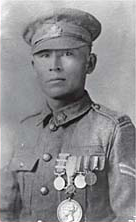
First Nations people come from many different backgrounds. They have rich histories, economies, cultures, and governments. Many First Nations people have become active politicians in the Canadian government. They feel great pride and patriotism for Canada. They also serve as leaders within their own First Nation governments. The Assembly of First Nations (AFN) is a national group that supports these governments.
- Shanawdithit, born in 1801, was the last known member of the Beothuk people. After she passed away in 1829, the Beothuk people were officially gone as a separate group.
- Aatsista-Mahkan (Running Rabbit) became chief of the Siksika Nation in 1871. He signed Treaty 7. His people continued to follow the bison until 1881. Then, they settled on a reserve near Calgary, Alberta.
- Big Bear (mistahi-maskwa) was a Cree leader. He was known for his role in the 1870 Battle of the Belly River.
- Francis Pegahmagabow was a First Nation soldier. He was the most decorated for bravery in Canadian military history. He was also the most effective sniper in World War I.
- Mary Greyeyes-Reid was the first First Nations woman to join the Canadian Forces.
- Tommy Prince was one of Canada's most decorated First Nations soldiers. He served in World War II and the Korean War.
- Mary John, Sr., CM, was a leader of the Dakelh (Carrier) people and a social activist. Her life story is told in the book Stoney Creek Woman.
- Ethel Blondin-Andrew was a Canadian politician of Dene descent. She was the first Indigenous woman elected to the Parliament of Canada.
- Ovide Mercredi is a Cree politician. He is a former national chief of the Assembly of First Nations.
- Harold Cardinal was a Cree writer, leader, teacher, and lawyer. He famously said First Nation peoples had the right to be "the red tile in the Canadian mosaic."
- Steven Point, OBC, was the Lieutenant Governor of British Columbia from 2007 to 2012. He is a lawyer and judge from the Skowkale First Nation.
- Theresa Spence is a chief of the Attawapiskat First Nation. She is known for her role in the Attawapiskat housing crisis and the Idle No More protest.
First Nations in Arts and Entertainment
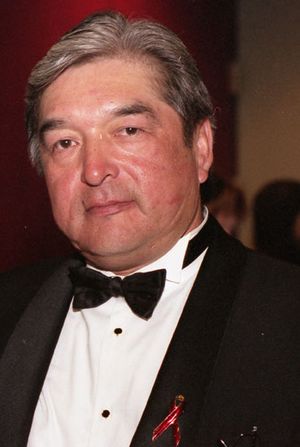
Indigenous peoples have achieved great success in arts and entertainment. Some have even been recognized at the Oscars, a major international award ceremony.
- Chief Dan George, OC, was chief of the Tsleil-Waututh First Nation. He was also an Academy Award-nominated actor and an author.
- Adam Beach is an actor of Saulteaux descent. He has played important roles in movies like Flags of Our Fathers and Windtalkers. He also starred in Canadian TV shows like Arctic Air.
- Lorne Cardinal is of Cree descent. He is known for playing First Nations roles. His most famous role was Davis Quinton on the Canadian TV series Corner Gas.
- Tantoo Cardinal is a Canadian film and television actress. She is of Métis and Cree descent.
- Graham Greene is an Academy Award–nominated Canadian actor. He is from the Oneida tribe. He was born on the Six Nations Reserve in Ontario.
- Shania Twain is a country pop artist with some Cree ancestry. She is one of only two Canadian musicians to sell over 2 million albums in Canada.
- Kashtin was a Canadian folk rock duo. It was made up of Innu artists Claude McKenzie and Florent Vollant.
- Robbie Robertson, a Mohawk musician, is best known for being a member of The Band.
- Norval Morrisseau, CM, was an Anishinaabe artist. He was known as the "Picasso of the North."
- Bill Reid, OBC, was an artist who brought new interest to his Haida art. He created amazing sculptures and totem poles.
First Nations in Sports
Many First Nations people have excelled in sports.
- Tom Longboat was an Onondaga distance runner. He was inducted into both Canada's Sports Hall of Fame and the Indian Hall of Fame.
- George "Chief" Armstrong was a professional hockey player. He was of Irish and Algonquin heritage.
- Ted Nolan, an Ojibwe, is a retired professional hockey player. He won the Jack Adams Award as a coach in the National Hockey League (NHL).
- Jonathan Cheechoo was the first person from the Moose Factory Cree Nation to play hockey for the Ottawa Senators in the NHL.
- Jon Mirasty, of Cree heritage, is a popular enforcer in the American Hockey League (AHL).
Inuit Leaders and Achievers
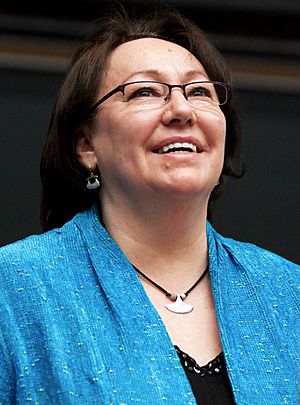
Inuit leaders have worked hard to support their communities. Some Inuit serve in a national political group called the Inuit Tapiriit Kanatami.
- Abe Okpik, CM, helped Inuit get surnames instead of disc numbers.
- Simonie Michael was the first Inuk elected to what is now the Legislative Assembly of the Northwest Territories. He also called for an end to disc numbers.
- Kiviaq (David Ward) was the first Inuk to become a lawyer. He helped establish important legal rights for the Inuit. In 2001, he won the right to use his single-word Inuktitut name.
- Peter Irniq, a former Commissioner of Nunavut, promoted the use of Inuit languages and culture. This culture is known as Inuit Qaujimajatuqangit or IQ.
- Sheila Watt-Cloutier, OC, is an Inuit political leader and activist. She has worked at local, national, and international levels. She was the International Chair of the Inuit Circumpolar Council.
- Nellie Cournoyea, OC, of Inupiat heritage, was the first female Premier of the Northwest Territories.
- Helen Maksagak, CM, a Copper Inuit, was the last Commissioner of the undivided Northwest Territories. She was also the first Commissioner of Nunavut.
- Paul Okalik was the first Premier of Nunavut. He wanted to help his people with the Canadian justice system.
- Ann Meekitjuk Hanson is the Commissioner of Nunavut. She is also a civil servant, broadcaster, journalist, and author.
Historically, some Inuit were important figures in trade and exploration.
- Stephen Angulalik was a well-known Ahiarmiut Inuit from northern Canada. He was a successful fur trader and ran a trading post.
- Ipirvik (Ebierbing), also known as "Eskimo Joe," was a guide and explorer. He helped many Arctic explorers in the 1860s and 1870s.
- Peter Pitseolak was an Inuit photographer, artist, and historian. He lived most of his life in traditional Inuit camps near Kinngait on Baffin Island.
Inuit in Arts and Entertainment
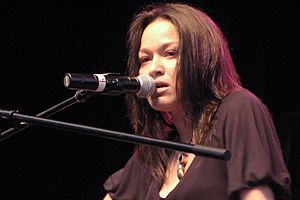
- Kenojuak Ashevak, CC, was a pioneer of modern Inuit art. Born in an igloo in 1927, she became one of the first Inuit women to start drawing in the late 1950s. Her carvings and prints are sought after by museums and collectors.
- Zacharias Kunuk is a producer and director. He is famous for his film Atanarjuat: The Fast Runner. This was the first Canadian feature film made entirely in Inuktitut. He co-founded Igloolik Isuma Productions, Canada's first independent Inuit production company.
- Annabella Piugattuk is a throat singer and actress. She is known for her role in The Snow Walker.
- Susan Aglukark is a three-time Juno Award-winning musician. Her music blends folk and Inuit music traditions with country and pop sounds.
- Tanya Tagaq Gillis is an Inuit throat singer. She performs as a solo artist, which is different from traditional duos.
- Charlie Panigoniak is a country singer-songwriter and guitarist. His albums often reflect on life in the North.
- Lucie Idlout is a rock singer. She writes songs that bring attention to important issues.
- Jessie Oonark was an internationally recognized artist. She was made an Officer of the Order of Canada.
- Alootook Ipellie was an illustrator and writer. He shared the stories of the Inuit through his work.
- Natar Ungalaaq is an actor, filmmaker, and sculptor. His artwork is found in many major Inuit art collections worldwide.
Inuit in Sports
- Jordin Tootoo is the first Inuk athlete to become a professional ice hockey player in the NHL.
Métis Leaders and Achievers
Métis people have made important contributions as military figures, business owners, and sports professionals.
- Historically, William Kennedy was an Arctic explorer. In 1851, he led an expedition to find Sir John Franklin.
- Gabriel Dumont helped bring Louis Riel back to Canada. He wanted Riel to pressure the Canadian government to help the Métis people.
- Louis Riel was a founder of the province of Manitoba. He was a leader of the Métis people of the Canadian Prairies. He led two rebellions against the Canadian government. These were the Red River Rebellion (1869–1870) and the North-West Rebellion (1885).
- Dumont served under Riel as a general in the Métis government in Saskatchewan in 1885. He then led the Métis forces in the North-West Rebellion.
- Elzéar Goulet was a Métis leader in the Red River Colony. He supported Louis Riel's provisional government. A park in Winnipeg is named after him.
- Charles Nolin was a Métis farmer and political organizer. He was also Louis Riel's first cousin.
- John Bruce was the first president of the Métis provisional government. He fought during the Red River Rebellion of 1869.
The Métis National Council is a national political organization for Métis people.
- Pearl Calahasen was the first Métis woman elected to public office in Alberta.
- Senator Thelma Chalifoux was the first Métis woman to receive the National Aboriginal Achievement Award.
- Blanche Brillon Macdonald was a business owner and activist. She developed the "Blanche Macdonald Centre."
- Suzanne Rochon-Burnett, CM, was a businesswoman and a founder of the Métis Nation of Ontario.
Métis in Arts and Entertainment
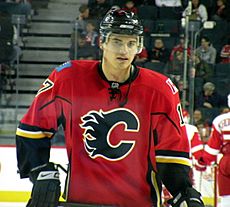
Métis culture is shown through the work of many artists.
- Christi Belcourt is a painter, craftsperson, and writer. She is known for her acrylic paintings. These paintings show floral patterns inspired by Métis and First Nations beadwork.
- Laura de Jonge is a family advocate, filmmaker, and magazine founder.
- George R. D. Goulet is a best-selling author. He has written several books about the Métis.
- Tom Jackson has starred in TV shows like North of 60. He has also released several country and folk music albums.
- Douglas Cardinal, OC, is a famous architect from Calgary. He is of Métis and Blackfoot heritage. He is known for his buildings with smooth, flowing lines.
Métis in Sports
Many Métis people are well-known in sports.
- Bryan Trottier is a retired professional ice hockey player. He played 18 seasons in the NHL and is in the Hockey Hall of Fame.
- Wade Redden is a professional ice hockey player. He has won two gold medals at the IIHF World U20 Championship.
- Rene Bourque is a professional ice hockey player in the NHL. He is the first cousin of boxing champion Wayne Bourque.
- Wayne Bourque has been the North American Native boxing champion three times.
See also
- Juno Award for Indigenous Artist or Group of the Year
- List of indigenous artists of the Americas
- List of place names in Canada of Indigenous origin
- List of writers from peoples indigenous to the Americas
- Persons of National Historic Significance (Canada)


